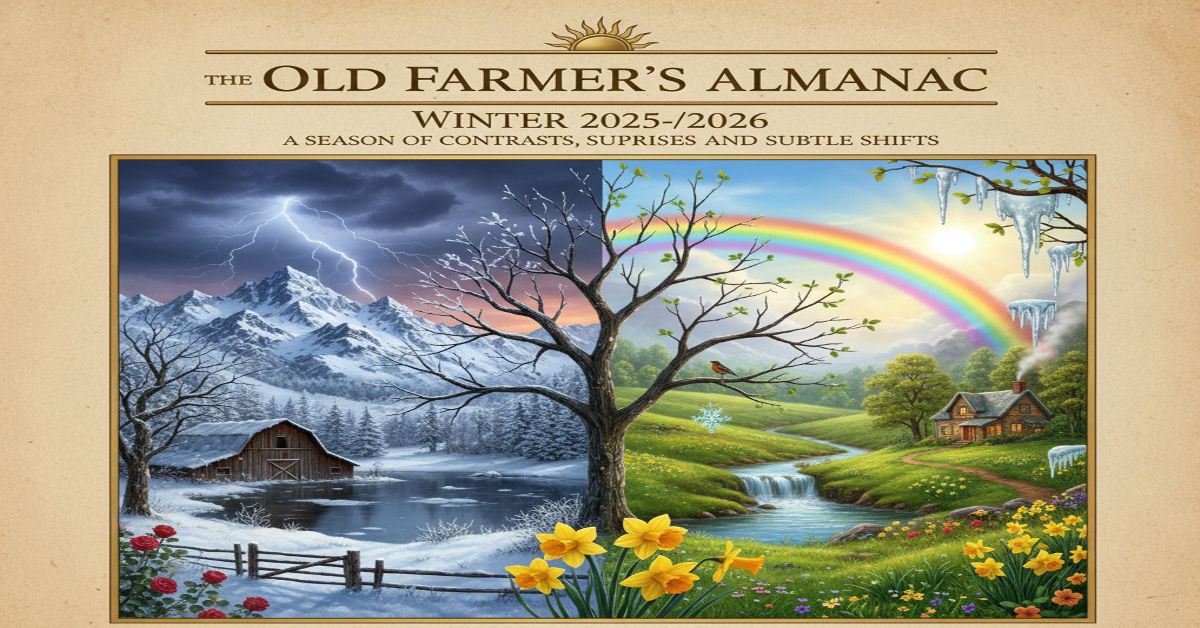Every winter carries its own rhythm but few seasons generate anticipation quite like the one predicted by the Old Farmer’s Almanac. The upcoming winter 2025/26 promises a mix of familiar cold, surprising warmth and regional extremes that could redefine how North Americans experience the coldest months of the year. According to the forecast, this season won’t be uniformly frigid or mild. Instead, it’s shaping up as a mosaic of micro-climates where some regions see snowier conditions and others enjoy prolonged thaws.
The enduring appeal of the Almanac lies not only in its forecasts but in the way it helps people prepare for life’s cycles. Farmers plan planting schedules, homeowners ready their heating systems, and travelers adjust itineraries, all informed by its pages. This winter’s predictions offer both comfort and caution while certain areas may escape harsh conditions, others could encounter bursts of icy weather that test even the best-laid plans.
The Legacy of the Old Farmer’s Almanac
Since its first publication in 1792, the Old Farmer’s Almanac has served as a guiding companion for generations seeking to understand nature’s patterns. It is the longest continuously published periodical in North America, merging traditional wisdom with modern insights. What began as a simple farmer’s tool has become a trusted national reference for long-range forecasts, gardening tips, and celestial events.
Its enduring success comes from the combination of science and storytelling. Each edition connects readers to the Earth’s cycles through a blend of factual forecasting and folklore. The Almanac’s popularity stems not just from curiosity about the weather but from the reassurance it provides in an uncertain world. When the winter forecast arrives each August, millions turn to it to glimpse what’s ahead—whether that means preparing barns for livestock, booking ski trips, or planning for potential storms.
How the Almanac Predicts the Winter Ahead
The Almanac’s long-range weather predictions are rooted in a proprietary blend of meteorology, climatology and solar science. The editors analyze sunspot activity, atmospheric patterns, and oceanic oscillations like El Niño and La Niña to anticipate upcoming trends. Though modern meteorologists at organizations such as the National Oceanic and Atmospheric Administration rely on dynamic computer models, the Almanac’s approach offers a more traditional, pattern-based perspective that resonates with those who value cyclical understanding.
Forecasting months in advance is complex. Solar radiation, jet-stream positioning, and regional air-pressure systems all influence how winter unfolds. For 2025/26, the Almanac interprets these signals to predict milder conditions in many northern zones, contrasted with bursts of intense cold in the Southeast and southern Appalachians. This dual pattern suggests a season of variability rather than uniformity, where some may be reaching for umbrellas while others shovel deeper drifts than expected.
The Big Picture: Key Trends for Winter 2025/26
Across the continental United States, the overarching theme is moderation. Temperatures are forecast to hover near normal or slightly above average for large portions of the country. Yet, balance never lasts long in weather, and specific pockets could experience notable deviations. The Southeast, Florida, and parts of the Appalachian corridor may encounter colder-than-normal conditions, while the West and Midwest enjoy milder air.
Precipitation follows its own patchwork design. Several areas, including the Intermountain West and parts of the southern High Plains, could see wetter weather than usual. Meanwhile, regions like New England, the Mid-Atlantic, and the Great Lakes may lean drier. For snow lovers, totals may run below average in many traditional snow belts, but the southern Rockies, Carolinas, and certain parts of the Ohio Valley could experience above-normal accumulation.
| Weather Element | National Trend | Regional Exceptions | Impact Summary |
| Temperature | Near to slightly above normal | Southeast, Appalachians, Florida may turn colder | Mixed heating demand; moderate energy savings in mild zones |
| Precipitation | Generally drier | Southwest, southern High Plains, Intermountain regions wetter | Dry soils could challenge spring planting in dry belts |
| Snowfall | Near or below normal | Southern Rockies, Carolinas, eastern Ohio Valley above | Uneven snow distribution affects tourism and water storage |
United States Regional Forecast Overview
The nation’s diversity in terrain and climate ensures that no single winter story fits all. From the frosty lakeshores of Michigan to the humid Gulf Coast, regional differences define daily experience. In the Northeast, the Almanac anticipates a relatively tame winter with lighter snowfall and occasional warm interludes. That means fewer disruptions for commuters but potentially less snowpack for ski resorts and water reserves.
In contrast, the Southeast could face sharper cold spells, especially through late December and early February. This region, accustomed to milder winters, may need to prepare for brief freezes that could damage crops and challenge infrastructure. The Midwest stands near the middle of the scale, with mixed precipitation and periods of calm alternating with sudden snow events. Out West, conditions may be influenced by Pacific patterns that bring bursts of rain to California and steady snow to the higher elevations of Colorado and New Mexico.
| Region | Temperature Outlook | Precipitation | Snowfall | Seasonal Note |
| Northeast | Slightly warmer than average | Drier than normal | Below normal | Easier travel but lower water reserve |
| Southeast | Colder than average | Slightly drier | Above average | Increased frost risk for crops |
| Midwest | Mild to near normal | Drier overall | Variable | Occasional snow bursts; travel delays possible |
| Intermountain West | Near average | Wetter | Above average | Promising for ski resorts |
| Pacific Coast | Above average | Variable | Below average | Possible late-season rains |
Canadian Winter Outlook
North of the border, the story evolves differently. The Old Farmer’s Almanac suggests that most of Canada will see a milder, wetter winter overall. The traditional deep freezes of the Prairies may ease slightly, while Atlantic Canada could experience bursts of snow that contrast with the milder trend elsewhere. For many provinces, the word “mixed” best captures what’s coming.
A milder winter sounds appealing, but it carries implications for snowpack, hydropower generation, and tourism. Ski destinations in British Columbia and Quebec might contend with fluctuating snow levels as freezing lines rise. Yet coastal and mountain regions may still enjoy pockets of heavy snow, ensuring a decent—if inconsistent—season for winter sports enthusiasts.
| Region | Temperature Trend | Precipitation | Snowfall | Notable Impacts |
| British Columbia | Above normal | Variable | Below average | Reduced snowpack at lower elevations |
| Prairies | Near to above normal | Near normal | Below average | Moderate heating costs |
| Ontario | Mild | Mixed | Below normal | Less ice cover on lakes |
| Quebec | Slightly above | Above normal | Below normal | Frequent rain-snow transitions |
| Atlantic Canada | Near normal | Above normal | Above normal | Occasional nor’easter events |
Month-by-Month Forecast Breakdown
Winter never arrives all at once. It builds gradually, each month layering its own personality upon the last. The following progression captures how the 2025/26 season might evolve.
November 2025 may start gently, with near-normal temperatures and intermittent rainfall. Early flurries could dust the higher elevations, signaling the first hints of winter. December 2025 brings stronger contrasts: sharp cold fronts may descend into the Southeast while the West enjoys temperate weather and sporadic snow.
By January 2026, the heart of winter asserts itself. Some regions experience brief thaws, others hunker down for deep freezes. February often defines the winter’s legacy, and this one looks no different—colder intervals may punctuate an otherwise moderate pattern. March 2026 becomes the transition month, when snow turns to slush and longer days invite the first thoughts of spring.
| Month | Temperature | Precipitation | Highlight |
| November 2025 | Mild start | Light rain/snow mix | Early-season preparation |
| December 2025 | Cooler South, milder North | Variable | Holiday travel caution |
| January 2026 | Fluctuating | Drier for many | Sporadic snowstorms |
| February 2026 | Cold surges East | Snowier South | Peak heating demand |
| March 2026 | Warming trend | Melting, runoff | Begin spring readiness |
This temporal view helps homeowners, farmers, and travelers align their seasonal activities with likely weather patterns instead of being caught off guard.
Impacts on Agriculture and Food Supply
Agriculture always feels winter’s influence long before spring planting begins. The forecast of milder temperatures across much of North America could reduce winterkill risks for certain crops and livestock. Yet, the flip side is that reduced snow cover in many areas might lower soil-moisture reserves critical for planting. Farmers who depend on consistent snowmelt may need to plan irrigation earlier than usual.
For regions expecting sharper cold, especially the Southeast and Appalachians, frost protection becomes vital. Farmers might consider insulating vulnerable plants, using row covers, or adjusting harvest schedules. According to the U.S. Department of Agriculture, climate variability continues to challenge predictable growing cycles, making adaptability the cornerstone of Old Farmer’s Almanac Winter 2025/26. In this context, the Almanac remains not just a curiosity but a practical planning tool that supports resilience and foresight.
Homeowners’ and Travelers’ Guide to Winter 2025/26
For homeowners, a slightly milder winter offers both relief and responsibility. Lower heating bills may coincide with more freeze-thaw cycles, which can stress building materials. Regular inspection of roofs, gutters, and plumbing is recommended to prevent leaks and damage. Even in regions expecting less snow, an unexpected ice storm can still cause disruption. The National Weather Service advises that homeowners maintain emergency kits with water, batteries, and backup power sources throughout the winter months.
Travelers face a similarly nuanced picture. Those in drier regions could experience fewer cancellations, but colder outbreaks in the Southeast might create brief hazards on roads unaccustomed to icy conditions Old Farmer’s Almanac Winter 2025/26. Airline travelers should stay alert during late December and February—two periods flagged by long-range forecasts for potential storm activity. Flexibility remains key booking refundable tickets and monitoring short-term forecasts can make a significant difference.
Snow, Ski and Winter-Sport Highlights
For snow enthusiasts, winter 2025/26 will not be evenly generous. The National Geographic climate analysis suggests that warming trends continue to affect lower-elevation snowfall, though alpine zones may still thrive when storm systems align. According to the Almanac, the southern Rockies and eastern Desert Southwest are likely to see above-average snow, providing potential hotspots for ski vacations.
In contrast, many northern and coastal resorts may contend with variable snowpack, alternating between heavy snow weeks and melt phases. The best strategy for skiers and snowboarders is to plan flexible trips and monitor snow-base data through real-time resources such as The Weather Channel’s seasonal snow tracker Old Farmer’s Almanac Winter 2025/26. For those new to winter sports, early February could offer optimal conditions in regions forecast for colder, snowier weather patterns.
Comparing Long-Range Forecasts and Accuracy
Long-range forecasting is equal parts science and interpretation. While the Old Farmer’s Almanac has its unique formula, meteorological institutions such as NASA Climate and NOAA use satellite data and atmospheric models to project seasonal outlooks Old Farmer’s Almanac Winter 2025/26. Comparing these sources reveals alignment on some points—particularly the expectation of a relatively mild North American winter influenced by global ocean patterns.
Accuracy remains a topic of debate. Independent analyses often find the Almanac’s predictions align directionally rather than precisely, averaging around 70 percent accuracy over the decades. Yet for many readers, the value lies less in numerical precision and more in guidance. Knowing whether to expect a generally cold, wet or dry season helps plan daily life from fuel budgets to vacation timing.
How to Prepare for the Season Ahead
Preparation is the bridge between forecast and comfort. For households, this means ensuring heating systems are tuned and insulation is intact before the first frost arrives Old Farmer’s Almanac Winter 2025/26. Homeowners in regions expecting colder-than-average spells should consider pipe insulation and verify that backup generators function correctly. It’s also smart to stock up on essentials early, as unpredictable storms can disrupt supply chains.
Farmers can begin winterizing equipment, inspecting irrigation lines, and updating contingency plans. Those in drier zones might focus on soil conservation and moisture retention, while those expecting heavier snow should secure storage structures and check drainage paths. Communities benefit when residents act proactively—small preparations collectively reduce the strain on emergency services during severe events.
Final Thoughts and Seasonal Call to Action
Old Farmer’s Almanac Winter 2025/26, is shaping up as a season of balance and variety rather than uniform hardship. Many will experience moderate temperatures, fewer blizzards and sporadic cold snaps that remind us that winter still has a voice. Others will see wet patterns and snow that renews the land in quieter, gentler ways.
The beauty of consulting the Almanac lies in its invitation to observe rather than merely endure. By aligning our habits with the cycles of nature, we rediscover the rhythm that earlier generations lived by. Whether you are a farmer, gardener, traveler, or simply a winter-lover, use this forecast to stay ahead of the season and to reconnect with the environment that shapes daily life.







